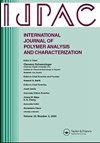硅烷偶联剂对聚乳酸基复合材料紫外线耐候性的影响
IF 1.7
4区 工程技术
Q4 POLYMER SCIENCE
International Journal of Polymer Analysis and Characterization
Pub Date : 2023-07-04
DOI:10.1080/1023666X.2023.2250620
引用次数: 0
摘要
摘要聚乳酸(PLA)具有良好的生物降解性和相容性,是一种很有前途的材料。然而,PLA复合材料的抗紫外线(UV)降解能力有限,阻碍了其在汽车内饰材料中的应用。在我们之前的工作中,我们成功地将kh550处理的微纳稻壳(MNRH)纤维与kh570处理的PLA结合制备了3D打印长丝,并表现出良好的性能。本研究旨在研究硅烷偶联剂、MNRH和加速紫外线老化时间对MNRH增强3D打印pla基复合材料光降解行为的影响。利用扫描电镜(SEM)、傅里叶变换红外(FTIR)、热重分析(TGA)和差示扫描量热法(DSC)对3D打印pla基复合材料进行表征。建立了抗拉强度与紫外老化时间的指数方程,为预测PLA复合材料汽车内饰材料的使用寿命提供了理论指导。形态学表征实验结果表明,随着紫外老化时间的延长,PLA和RH6-KH550/KH570复合材料均由透明向半透明转变。这种转变可归因于在UV老化过程中聚乳酸分子链和化学键的断裂。FTIR测试结果显示复合材料中羧酸的形成,C = O吸收强度的降低表明MNRH和硅烷偶联剂对RH6-KH550/KH570复合材料的UV耐久性具有稳定作用。TGA和DSC结果表明,KH550和KH570延缓了pla基复合材料的光降解速率。本文章由计算机程序翻译,如有差异,请以英文原文为准。
Effect of silane coupling agent on the ultraviolet weathering behavior of polylactic acid based composites
Abstract Polylactic acid (PLA) is a promising material due to its biodegradability and compatibility. However, the limited resistance to ultraviolet (UV) degradation of PLA composites hinders their use in automotive interior materials. In our previous work, we successfully prepared 3D printed filaments by combining KH550-treated micro-nano rice husk (MNRH) fibers with KH570-treated PLA, which exhibited favorable performance. This study aimed to investigate the effects of silane coupling agents, MNRH, and accelerated UV weathering time on the photodegradation behavior of 3D printed PLA-matrix composites reinforced with MNRH. Scanning electron microscopy (SEM), Fourier transform infrared (FTIR), thermogravimetric analysis (TGA), and differential scanning calorimetry (DSC) were utilized to characterize the 3D printed PLA-matrix composites. Furthermore, an exponential equation between tensile strength and UV weathering time was established, providing theoretical guidance for predicting the service life of automotive interior materials based on PLA composites. The morphological characterization experimental results indicate that with prolonged UV aging time, both PLA and RH6-KH550/KH570 composite materials transitioned from transparency to translucency. This transition can be attributed to the rupture of polylactic acid molecular chains and chemical bonds during the UV aging process. FTIR test results revealed the formation of carboxylic acid in the composite, and the reduction of C = O absorption intensity indicated that MNRH and silane coupling agents exhibited a stabilizing effect on the UV durability of the RH6-KH550/KH570 composite. TGA and DSC results indicated that KH550 and KH570 delayed the photodegradation rate of PLA-matrix composites.
求助全文
通过发布文献求助,成功后即可免费获取论文全文。
去求助
来源期刊
CiteScore
3.50
自引率
5.30%
发文量
37
审稿时长
1.6 months
期刊介绍:
The scope of the journal is to publish original contributions and reviews on studies, methodologies, instrumentation, and applications involving the analysis and characterization of polymers and polymeric-based materials, including synthetic polymers, blends, composites, fibers, coatings, supramolecular structures, polysaccharides, and biopolymers. The Journal will accept papers and review articles on the following topics and research areas involving fundamental and applied studies of polymer analysis and characterization:
Characterization and analysis of new and existing polymers and polymeric-based materials.
Design and evaluation of analytical instrumentation and physical testing equipment.
Determination of molecular weight, size, conformation, branching, cross-linking, chemical structure, and sequence distribution.
Using separation, spectroscopic, and scattering techniques.
Surface characterization of polymeric materials.
Measurement of solution and bulk properties and behavior of polymers.
Studies involving structure-property-processing relationships, and polymer aging.
Analysis of oligomeric materials.
Analysis of polymer additives and decomposition products.

 求助内容:
求助内容: 应助结果提醒方式:
应助结果提醒方式:


